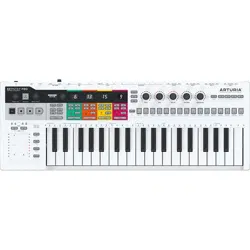Loading ...
Loading ...
Loading ...

6.4.6. Bottom-Up
The second approach is more bottom-up and improvisational. You'll start by creating
Patterns, improvising as you go, and then developing more and more Patterns by mangling,
inverting and/or transposing a number of basic Patterns with themes that you like.
Next, you'll want to organize these Patterns into Chains, feeling your way through
combinations of Patterns, making decisions about how to chain them for the musical
feelings and developments you're after.
In the final stage, you decide which tracks/voices will play and save your choices in a Scene.
You repeat this until you have three or more Scenes.
6.4.7. Top-Down or Bottom-up?
Both approaches have their own merits, and it's probably a good idea to give both a try to
see what fits your style of composing or improvising.
6.4.8. Other things to try
Create very short Patterns of only two notes, but vary velocity and gate length in each
Pattern.
Keep the number 12 in mind when making decisions about Pattern lengths, because it can
be divided in so many ways;
• 2+2+2+2+2+2
• 3+3+3+3
• 4+4+4
• 6+6
and mixtures of these numbers:
• 2+3+2+3+2
• 4+2+6
and many others. By combining Patterns of these lengths it is easy to keep your Patterns
more or less in sync. Of course, if sync is not what you're after, throw in a few odd numbers.
The number 9 has interesting permutations:
• 3+3+3
• 4+5 or 5+4
• 3+2+2+2 or 2+2+3+2
Whatever you do, enjoy it!
Arturia - User Manual Keystep Pro - What is a Project? 131
Loading ...
Loading ...
Loading ...
